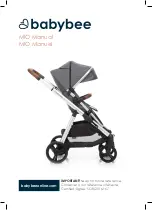
43
Q: HOW CAN I IMPROVE THE TOOL
’
S REPEATABILITY?
Generally speaking, slowing the tool down will improve its repeatability. Reducing the RPM
FREE% value will give the tool more time to react as it approaches the target torque. Reducing
the DOWNSHIFT TQ and/or RPM DOWN% may also have the same effect. Keep in mind that
tool
’
s RPM and Downshift points can affect ergonomics and overall productivity also; testing
and running the tool on an application are the only ways to verify that the parameter set meets
all requirements of the manufacturing process. Consistency of the joint characteristics must
also be considered.
Q: HOW SHOULD I ADJUST THE SETTINGS FOR HARD JOINTS?
Because of how quickly torque rises upon reaching threshold torque, the tool should slow down
to minimize overshooting the target torque. Two speed adjustments may be necessary. Main-
tain
a
reasonable
RPM
FREE%
and
RPM
DOWN%
during
the
rundown. Reduce the DWNSHIFT (downshift torque) setting to give the tool more time to react
once hitting the threshold torque. A value slightly above the THOLD (threshold torque) is rec-
ommended.
Q: HOW SHOULD I ADJUST THE SETTINGS FOR SOFT JOINTS?
A softer joint requires more tightening time. You can afford to increase the speed
during the rundown and still maintain acceptable repeatability. Increase the DWNSHIFT
(downshift torque) setting a little at a time to decrease cycle time while still meeting the torque
limit requirements.
Q: THE TOOL DOESN
’
T OPERATE WHEN I PRESS THE LEVER
.
One common cause of this is choosing the improper tool for the parameter set; if the target
torque value is above the tool
’
s maximum rating then the tool will not run and
“
FLT EXT1
4096”
will
be
displayed
on
the
Main
Display
Panel.
Another
common
reason for this problem is that the control ring on the tool is in a position that is
programmed as NEUTRAL, the MFB button has been programmed for a non running scenario
or the tool is running off I/O. Refer to the ToolWare Users Guide to correct this situation.
Q: HOW DO I CHANGE THE UNITS OF MEASURE?
The units of measure for torque is a universal setting for all parameter sets. To change the
units, go to the Admin menu on the KDM and choose Pset Defaults. Keep in mind that the con-
troller does not convert values for you. If you have a parameter setting of 10 Nm and you
change the units to ft
-
lbs, the new setting is 10 ft
-
lbs. Changing the units of measure using
Toolware allow for calculation of values. Refer to the Toolware users guide for more details.
Lastly, being a universal setting, all parameter sets will use the same unit of measure.
Q: SHOULD I USE ERGO MODE?
At higher torque settings, using the Ergo Mode may seem more comfortable for some opera-
tors. The Ergo Mode releases the torque over a longer period of time, resulting in more gentle
torque reaction. It
’
s a personal preference; some operators prefer the Ergo
Mode and some
prefer to disable it. Ergo Mode is only enabled with 2000 series
AcraDyne tools and may have a negative effect on cPk calculations.
APPENDIX G: FAQ
’
S
Summary of Contents for iEC
Page 1: ...AcraDyne iEC DC Tool Controllers User Guide...
Page 35: ...35 Appendix B KDM Menu Structures Main Menu Structure Parameter Set up Menu...
Page 36: ...36 APPENDIX B KDM Menu Structures Administration Menu...
Page 45: ...45 Notes...
Page 46: ...46 Notes...
Page 47: ...47 Notes...





































